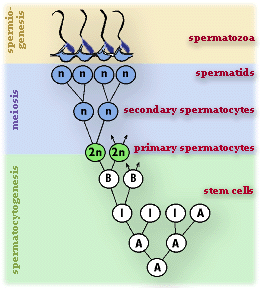 CORE TOPIC: PAGE 1 of 4
CORE TOPIC: PAGE 1 of 4 CORE TOPIC: PAGE 1 of 4
CORE TOPIC: PAGE 1 of 4
Spermatogenesis The male gametes are produced by a process known as spermatogenesis. Testosterone initiates spermatogenesis at puberty and controls its rate throughout life. Spermatogenesis can be described in three stages.
Spermatogenesis is sensitive to temperature change and various chemical stimuli. In virtually all mammals, the testes are maintained two degrees below the core body temperature; a rise in temperature results in a fall in the rate of spermatogenesis. The low temperature is acheived by the testes lying outside the body cavity in the scrotum. In addition, the arterial blood entering the testes is cooled by inimate contact with a copmlex arrangement of veins which acts as a counter current heat exchange mechanism.
Spermatogenesis
Page 1
Page 2 ->| Core | Supplementary Material on Spermatogenesis | ||
| Previous Topic Next Topic | Seminiferous tubule (MP) | Spermatogenesis (VHP) | Sertoli cells diagram |
| Sertoli cells (VHP) | Spermatozoa | - | Return to Male Reproductive System Main Index |